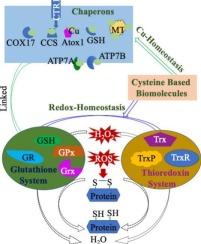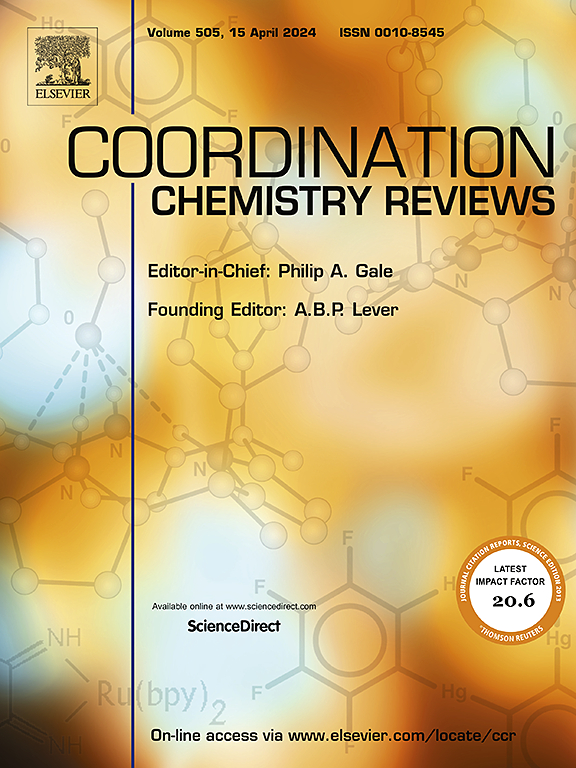基于半胱氨酸的生物大分子调节细胞的铜和氧化还原平衡
IF 20.3
1区 化学
Q1 CHEMISTRY, INORGANIC & NUCLEAR
引用次数: 0
摘要
内稳态是细胞的一种平衡状态,对细胞的正常功能、生长和长期生存至关重要。否则,不平衡的体内平衡会引发许多疾病。具体来说,以半胱氨酸(Cys)为基础的生物分子参与细胞稳态。一组基于cys的蛋白质称为Cu-chaperons,通过与伴侣蛋白根据亲和力梯度交换Cu和半胱氨酸配体,适当地分配和排泄多余的Cu,从而维持细胞内Cu的平衡。其他基于cys的蛋白质组作为氧化还原开关,特别是“谷胱甘肽系统”(谷胱甘肽、谷胱甘肽过氧化物酶、谷胱甘肽还原酶和谷胱甘肽还原酶)和“硫氧还蛋白系统”(硫氧还蛋白和硫氧还蛋白还原酶),它们通过可逆的硫醇-二硫交换来控制细胞氧化还原平衡,这是细胞氧化还原稳态的中心氧化还原枢纽。此外,Cu稳态与氧化还原系统有关,两者可以协同平衡细胞Cu和氧化还原。因此,本文将关注基于Cys的蛋白的两个重要作用:细胞铜稳态和氧化还原稳态,其中铜运输和氧化还原调控的结构和机制,以及铜伴侣与细胞氧化还原系统的密切关系,以及相同的Cys基序(CXXC)在不同蛋白中的不同功能/氧化还原电位。本文章由计算机程序翻译,如有差异,请以英文原文为准。


Cysteine-based biomolecules regulate cellular copper- and redox-homeostasis
Homeostasis, a balance state in cells, is crucial for proper cellular function, growth, and long-term survival. Otherwise, imbalanced homeostasis fosters many diseases. Specifically, cysteine (Cys)-based biomolecules are involved in cellular homeostasis. A group of Cys-based proteins called Cu-chaperons properly distributes and excretes excess Cu by exchanging Cu and cysteine ligands with partner proteins according to their affinity gradient, thus maintaining a balance of cellular Cu. Other groups of Cys-based proteins act as redox switches, especially, “glutathione systems” (glutathione, glutathione peroxidases, glutaredoxins, and glutathione reductase) and “thioredoxin systems” (thioredoxin, and thioredoxin reductase) that detoxify the reactive oxygen species (ROS) or oxidative damaged biomolecules to control the cellular redox balance through a reversible thiol-disulfide exchange, which is the central redox hub for cellular redox homeostasis. Moreover, Cu-homeostasis is linked to the redox system and both may synergistically balance the cellular Cu and redox. Therefore, this review brings attention to two important roles of Cys-based proteins: cellular copper-homeostasis and redox-homeostasis, wherein structures and mechanisms of Cu-trafficking and redox regulation, followed by a close relationship between Cu-chaperons and cellular redox systems, and different functions/redox potentials of the same Cys motif (CXXC) in various proteins are considered.
求助全文
通过发布文献求助,成功后即可免费获取论文全文。
去求助
来源期刊

Coordination Chemistry Reviews
化学-无机化学与核化学
CiteScore
34.30
自引率
5.30%
发文量
457
审稿时长
54 days
期刊介绍:
Coordination Chemistry Reviews offers rapid publication of review articles on current and significant topics in coordination chemistry, encompassing organometallic, supramolecular, theoretical, and bioinorganic chemistry. It also covers catalysis, materials chemistry, and metal-organic frameworks from a coordination chemistry perspective. Reviews summarize recent developments or discuss specific techniques, welcoming contributions from both established and emerging researchers.
The journal releases special issues on timely subjects, including those featuring contributions from specific regions or conferences. Occasional full-length book articles are also featured. Additionally, special volumes cover annual reviews of main group chemistry, transition metal group chemistry, and organometallic chemistry. These comprehensive reviews are vital resources for those engaged in coordination chemistry, further establishing Coordination Chemistry Reviews as a hub for insightful surveys in inorganic and physical inorganic chemistry.
 求助内容:
求助内容: 应助结果提醒方式:
应助结果提醒方式:


